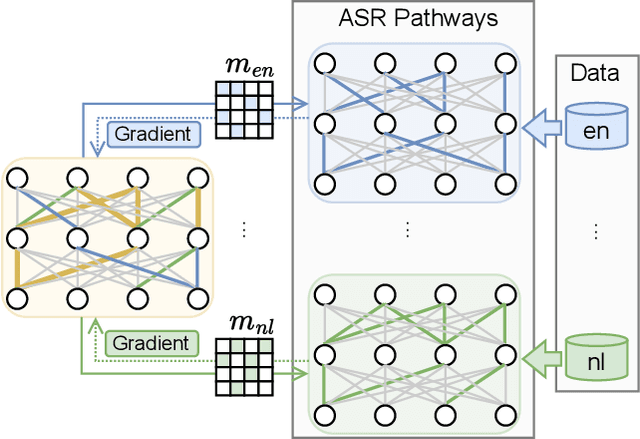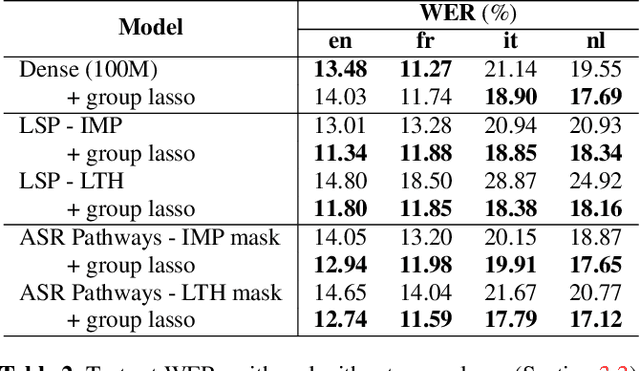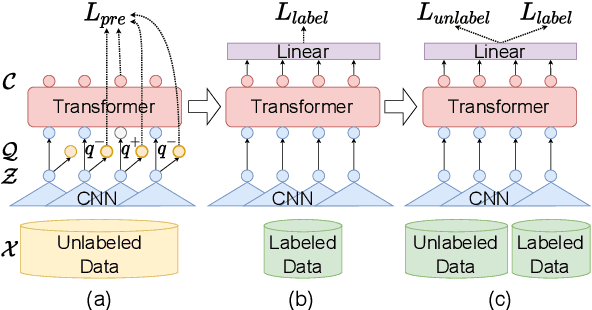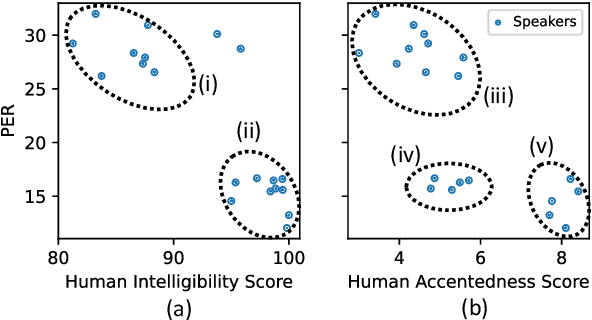Mu Yang
Bridging the Modality Gap: Softly Discretizing Audio Representation for LLM-based Automatic Speech Recognition
Jun 06, 2025Abstract:One challenge of integrating speech input with large language models (LLMs) stems from the discrepancy between the continuous nature of audio data and the discrete token-based paradigm of LLMs. To mitigate this gap, we propose a method for integrating vector quantization (VQ) into LLM-based automatic speech recognition (ASR). Using the LLM embedding table as the VQ codebook, the VQ module aligns the continuous representations from the audio encoder with the discrete LLM inputs, enabling the LLM to operate on a discretized audio representation that better reflects the linguistic structure. We further create a soft "discretization" of the audio representation by updating the codebook and performing a weighted sum over the codebook embeddings. Empirical results demonstrate that our proposed method significantly improves upon the LLM-based ASR baseline, particularly in out-of-domain conditions. This work highlights the potential of soft discretization as a modality bridge in LLM-based ASR.
Autoregressive Meta-Actions for Unified Controllable Trajectory Generation
May 29, 2025



Abstract:Controllable trajectory generation guided by high-level semantic decisions, termed meta-actions, is crucial for autonomous driving systems. A significant limitation of existing frameworks is their reliance on invariant meta-actions assigned over fixed future time intervals, causing temporal misalignment with the actual behavior trajectories. This misalignment leads to irrelevant associations between the prescribed meta-actions and the resulting trajectories, disrupting task coherence and limiting model performance. To address this challenge, we introduce Autoregressive Meta-Actions, an approach integrated into autoregressive trajectory generation frameworks that provides a unified and precise definition for meta-action-conditioned trajectory prediction. Specifically, We decompose traditional long-interval meta-actions into frame-level meta-actions, enabling a sequential interplay between autoregressive meta-action prediction and meta-action-conditioned trajectory generation. This decomposition ensures strict alignment between each trajectory segment and its corresponding meta-action, achieving a consistent and unified task formulation across the entire trajectory span and significantly reducing complexity. Moreover, we propose a staged pre-training process to decouple the learning of basic motion dynamics from the integration of high-level decision control, which offers flexibility, stability, and modularity. Experimental results validate our framework's effectiveness, demonstrating improved trajectory adaptivity and responsiveness to dynamic decision-making scenarios. We provide the video document and dataset, which are available at https://arma-traj.github.io/.
DRoPE: Directional Rotary Position Embedding for Efficient Agent Interaction Modeling
Mar 19, 2025Abstract:Accurate and efficient modeling of agent interactions is essential for trajectory generation, the core of autonomous driving systems. Existing methods, scene-centric, agent-centric, and query-centric frameworks, each present distinct advantages and drawbacks, creating an impossible triangle among accuracy, computational time, and memory efficiency. To break this limitation, we propose Directional Rotary Position Embedding (DRoPE), a novel adaptation of Rotary Position Embedding (RoPE), originally developed in natural language processing. Unlike traditional relative position embedding (RPE), which introduces significant space complexity, RoPE efficiently encodes relative positions without explicitly increasing complexity but faces inherent limitations in handling angular information due to periodicity. DRoPE overcomes this limitation by introducing a uniform identity scalar into RoPE's 2D rotary transformation, aligning rotation angles with realistic agent headings to naturally encode relative angular information. We theoretically analyze DRoPE's correctness and efficiency, demonstrating its capability to simultaneously optimize trajectory generation accuracy, time complexity, and space complexity. Empirical evaluations compared with various state-of-the-art trajectory generation models, confirm DRoPE's good performance and significantly reduced space complexity, indicating both theoretical soundness and practical effectiveness. The video documentation is available at https://drope-traj.github.io/.
UniScene: Unified Occupancy-centric Driving Scene Generation
Dec 06, 2024Abstract:Generating high-fidelity, controllable, and annotated training data is critical for autonomous driving. Existing methods typically generate a single data form directly from a coarse scene layout, which not only fails to output rich data forms required for diverse downstream tasks but also struggles to model the direct layout-to-data distribution. In this paper, we introduce UniScene, the first unified framework for generating three key data forms - semantic occupancy, video, and LiDAR - in driving scenes. UniScene employs a progressive generation process that decomposes the complex task of scene generation into two hierarchical steps: (a) first generating semantic occupancy from a customized scene layout as a meta scene representation rich in both semantic and geometric information, and then (b) conditioned on occupancy, generating video and LiDAR data, respectively, with two novel transfer strategies of Gaussian-based Joint Rendering and Prior-guided Sparse Modeling. This occupancy-centric approach reduces the generation burden, especially for intricate scenes, while providing detailed intermediate representations for the subsequent generation stages. Extensive experiments demonstrate that UniScene outperforms previous SOTAs in the occupancy, video, and LiDAR generation, which also indeed benefits downstream driving tasks.
Audiobox TTA-RAG: Improving Zero-Shot and Few-Shot Text-To-Audio with Retrieval-Augmented Generation
Nov 07, 2024Abstract:Current leading Text-To-Audio (TTA) generation models suffer from degraded performance on zero-shot and few-shot settings. It is often challenging to generate high-quality audio for audio events that are unseen or uncommon in the training set. Inspired by the success of Retrieval-Augmented Generation (RAG) in Large Language Model (LLM)-based knowledge-intensive tasks, we extend the TTA process with additional conditioning contexts. We propose Audiobox TTA-RAG, a novel retrieval-augmented TTA approach based on Audiobox, a conditional flow-matching audio generation model. Unlike the vanilla Audiobox TTA solution which generates audio conditioned on text, we augmented the conditioning input with retrieved audio samples that provide additional acoustic information to generate the target audio. Our retrieval method does not require the external database to have labeled audio, offering more practical use cases. To evaluate our proposed method, we curated test sets in zero-shot and few-shot settings. Our empirical results show that the proposed model can effectively leverage the retrieved audio samples and significantly improve zero-shot and few-shot TTA performance, with large margins on multiple evaluation metrics, while maintaining the ability to generate semantically aligned audio for the in-domain setting. In addition, we investigate the effect of different retrieval methods and data sources.
DiariST: Streaming Speech Translation with Speaker Diarization
Sep 14, 2023

Abstract:End-to-end speech translation (ST) for conversation recordings involves several under-explored challenges such as speaker diarization (SD) without accurate word time stamps and handling of overlapping speech in a streaming fashion. In this work, we propose DiariST, the first streaming ST and SD solution. It is built upon a neural transducer-based streaming ST system and integrates token-level serialized output training and t-vector, which were originally developed for multi-talker speech recognition. Due to the absence of evaluation benchmarks in this area, we develop a new evaluation dataset, DiariST-AliMeeting, by translating the reference Chinese transcriptions of the AliMeeting corpus into English. We also propose new metrics, called speaker-agnostic BLEU and speaker-attributed BLEU, to measure the ST quality while taking SD accuracy into account. Our system achieves a strong ST and SD capability compared to offline systems based on Whisper, while performing streaming inference for overlapping speech. To facilitate the research in this new direction, we release the evaluation data, the offline baseline systems, and the evaluation code.
What Can an Accent Identifier Learn? Probing Phonetic and Prosodic Information in a Wav2vec2-based Accent Identification Model
Jun 10, 2023Abstract:This study is focused on understanding and quantifying the change in phoneme and prosody information encoded in the Self-Supervised Learning (SSL) model, brought by an accent identification (AID) fine-tuning task. This problem is addressed based on model probing. Specifically, we conduct a systematic layer-wise analysis of the representations of the Transformer layers on a phoneme correlation task, and a novel word-level prosody prediction task. We compare the probing performance of the pre-trained and fine-tuned SSL models. Results show that the AID fine-tuning task steers the top 2 layers to learn richer phoneme and prosody representation. These changes share some similarities with the effects of fine-tuning with an Automatic Speech Recognition task. In addition, we observe strong accent-specific phoneme representations in layer 9. To sum up, this study provides insights into the understanding of SSL features and their interactions with fine-tuning tasks.
Learning ASR pathways: A sparse multilingual ASR model
Sep 13, 2022



Abstract:Neural network pruning can be effectively applied to compress automatic speech recognition (ASR) models. However, in multilingual ASR, performing language-agnostic pruning may lead to severe performance degradation on some languages because language-agnostic pruning masks may not fit all languages and discard important language-specific parameters. In this work, we present ASR pathways, a sparse multilingual ASR model that activates language-specific sub-networks ("pathways"), such that the parameters for each language are learned explicitly. With the overlapping sub-networks, the shared parameters can also enable knowledge transfer for lower resource languages via joint multilingual training. We propose a novel algorithm to learn ASR pathways, and evaluate the proposed method on 4 languages with a streaming RNN-T model. Our proposed ASR pathways outperform both dense models (-5.0% average WER) and a language-agnostically pruned model (-21.4% average WER), and provide better performance on low-resource languages compared to the monolingual sparse models.
Improving Mispronunciation Detection with Wav2vec2-based Momentum Pseudo-Labeling for Accentedness and Intelligibility Assessment
Apr 07, 2022



Abstract:Current leading mispronunciation detection and diagnosis (MDD) systems achieve promising performance via end-to-end phoneme recognition. One challenge of such end-to-end solutions is the scarcity of human-annotated phonemes on natural L2 speech. In this work, we leverage unlabeled L2 speech via a pseudo-labeling (PL) procedure and extend the fine-tuning approach based on pre-trained self-supervised learning (SSL) models. Specifically, we use Wav2vec 2.0 as our SSL model, and fine-tune it using original labeled L2 speech samples plus the created pseudo-labeled L2 speech samples. Our pseudo labels are dynamic and are produced by an ensemble of the online model on-the-fly, which ensures that our model is robust to pseudo label noise. We show that fine-tuning with pseudo labels gains a 5.35% phoneme error rate reduction and 2.48% MDD F1 score improvement over a labeled-samples-only fine-tuning baseline. The proposed PL method is also shown to outperform conventional offline PL methods. Compared to the state-of-the-art MDD systems, our MDD solution achieves a more accurate and consistent phonetic error diagnosis. In addition, we conduct an open test on a separate UTD-4Accents dataset, where our system recognition outputs show a strong correlation with human perception, based on accentedness and intelligibility.
InverseMV: Composing Piano Scores with a Convolutional Video-Music Transformer
Dec 31, 2021



Abstract:Many social media users prefer consuming content in the form of videos rather than text. However, in order for content creators to produce videos with a high click-through rate, much editing is needed to match the footage to the music. This posts additional challenges for more amateur video makers. Therefore, we propose a novel attention-based model VMT (Video-Music Transformer) that automatically generates piano scores from video frames. Using music generated from models also prevent potential copyright infringements that often come with using existing music. To the best of our knowledge, there is no work besides the proposed VMT that aims to compose music for video. Additionally, there lacks a dataset with aligned video and symbolic music. We release a new dataset composed of over 7 hours of piano scores with fine alignment between pop music videos and MIDI files. We conduct experiments with human evaluation on VMT, SeqSeq model (our baseline), and the original piano version soundtrack. VMT achieves consistent improvements over the baseline on music smoothness and video relevance. In particular, with the relevance scores and our case study, our model has shown the capability of multimodality on frame-level actors' movement for music generation. Our VMT model, along with the new dataset, presents a promising research direction toward composing the matching soundtrack for videos. We have released our code at https://github.com/linchintung/VMT
 Add to Chrome
Add to Chrome Add to Firefox
Add to Firefox Add to Edge
Add to Edge